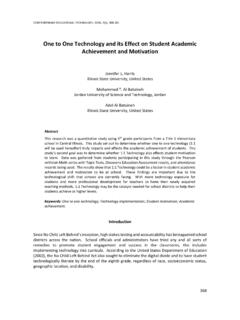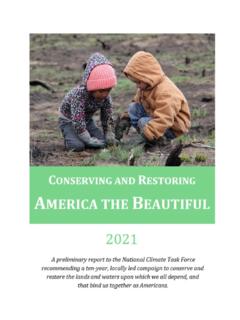Transcription of Early Childhood Education Report
1 Early Childhood Education Report2014 Early Childhood Education Report 2014 is published by: Ontario Institute for Studies in Education / University of Toronto 252 Bloor Street West, Toronto ON M5S 1V6 ISBN 978-1-928167-02-0 The Ontario Institute for Studies in Education holds the copyright to the Early Childhood Education Report 2014. It encourages digital or hard copy reproduction of the materials in whole or in part for teaching or non-profit use, providing full acknowledgement is given. Copying in any other circumstances, including but not limited to any commercial use, re-use in commercial publications, or for translation or adaptation, is not permitted without prior written permission from OISE. To request permission to reprint or republish material from this site, or if you are unclear who is the copyright holder, please contact: this publication as: Akbari, E., McCuaig, K. (2014) Early Childhood Education Report 2014. Toronto: Ontario Institute for Studies in USED IN Early Childhood Education Report 2014 Early Childhood Education (ECE) refers to programs for young children based on an explicit curriculum delivered by qualified staff and designed to support children s development and learning.
2 Settings may include child care centres, nursery schools, preschools, pre- or junior kindergarten and kindergarten. Attendance is regular and children may participate on their own or with a parent or caregiver. Early Childhood educators refers to the adults who work directly with children in Early Childhood Education settings, have ECE post-secondary Education credentials and are recognized by provincial/territorial legislation as qualified to teach in licensed child care, nursery schools, preschool or kindergarten is a way of structuring learning experiences as an organized program of activities. In Early Childhood Education , learning experiences include everything that happens to a child from arrival to following abbreviations of provincial/territorial names are used in this Report :NL Newfoundland and LabradorPE Prince Edward IslandNS Nova ScotiaNB New BrunswickQC Qu becON OntarioMB ManitobaSK SaskatchewanAB AlbertaBC British ColumbiaYK YukonNT Northwest TerritoriesNU Nunavut3 ACKNOWLEDGEMENTSMany people read and provided invaluable information for this Report .
3 We appreciate the thoughtful and insightful comments provided by Alexis Gagn , Jane Bertrand, Pat Wedge, Ann Robertson, Sue Deloney, Christine Maclean, Ann Sherman, Joanne Murrell, Charles Pascal, Zeenat Janmohamed, Christine Nunez, Andr Plamondon, Fran ois Lagarde and Jennifer would like to acknowledge the Atkinson Centre at the Ontario Institute for Studies in Education /University of Toronto and the support and encouragement provided by its chair, Dr. Jennifer Jenkins, and its faculty and administration. Also to the Connaught Global Challenge Award, University of Toronto that supports the work of Dr. Emis Akbari. We can not find the words to express our gratitude to our project director, Stacey Mudie, who kept unlimited drafts of text and figures in play, and who organized all the logistics that allowed the Report to would like to highlight the vital contribution of Statistics Canada to this project. Helping Canadians understand their country its population, resources, economy, society and culture is critical to protecting our democracy.
4 The quality information generated by the department is invaluable for evidence-based policy making at every level of also to the staff of provincial and territorial departments and ministries who gave generously of their time to respond to our contacted included:Newfoundland and Labrador Department of child , Youth and Family Services Department of Education and Early Childhood Development Department of Health and Community ServicesNew BrunswickDepartment of Education and Early Childhood DevelopmentNova ScotiaDepartment of Education and Early Childhood DevelopmentPrince Edward IslandDepartment of Education and Early Childhood DevelopmentQu becMinistry of Children and Youth Services Ministry of Education , Leisure and SportsOntarioMinistry of EducationManitobaHealthy child Manitoba Family Services Education and Advanced LearningSaskatchewanMinistry of EducationAlbertaAlberta Children and Youth Services Alberta EducationBritish ColumbiaMinistry of Children and Family Development Ministry of EducationNorthwest TerritoriesDepartment of Education , Culture and EmploymentThe production of this Report was made possible thanks to the skill and patience of the following.
5 Our copy editors, Janice Dyer (English) and Maryse Froment-Lebeau (French); Claire Gascon-Giard, who provided invaluable feedback as she led the French translation made by Asiatis; graphic designers Erin Holmes of Soplari Design and Greg Slater of Thistle Printing. The authors would also like to acknowledge Kathleen McBride and Cranberryink for the website development and With Intent for its communications Atkinson Centre sincerely thanks its funding partners (listed here) whose support is essential to the creation and dissemination of the Early Childhood Education Report are grateful to the Lucie and Andr Chagnon Foundation who sponsored the French translation for the Report and contributed to its content development and dissemination in Qu bec. Our admiration goes to the Jimmy Pratt Foundation who has used both editions of the ECE Report to great effect in Newfoundland. While appreciating the input of many, the authors accept full responsibility for the content of the Early Childhood Education Report 2014.
6 Emis Akbari, Kerry McCuaig 4In Canada, Education and child care fall primarily within the jurisdiction of provinces and territories, although there is a long history of federal involvement both through transfers to individuals and to provincial and territorial governments. While the federal government has been an inconsistent player in Early Childhood policy, it has influenced provincial and territorial programs and 2004 Speech from the Throne announced that the federal government would work with the provinces to create a national system of Early learning and child care. As a condition of $5-billion in funding over 5 years announced in the 2005 federal budget, provinces signed bi-lateral agreements-in-principle committing to develop detailed action plans that identified their spending priorities for Early learning and child care. Plans were to address the four QUAD principles: quality, universality, accessibility and developmental programming.
7 A federal election and a new government terminated this funding. In March 2007, the $5-billion commitment disappeared. Instead, $250 million a year was earmarked for a Community child Care Investment Program and transferred to provincial and territorial governments. A 25 percent tax credit was made available to businesses to create licensed child care spaces in the The latter, as predicted, received very little take up (see Figure ).Despite its short tenure, QUAD left a legacy. Many provinces continued to develop and pursue their action plans, even without federal funding. In fact, investments in Early learning and care across Canada more than doubled from $ billion in 2006 to $ billion in 2011. By 2014, provinces and territories were spending $ on Early Education and child care. Remnants of other federal/provincial efforts to develop a pan-Canadian approach to supporting young children and their families also Childhood Development initiative (2000)The Early Childhood Development initiative (ECDI) provides $500 million annually for programs to promote infant and maternal health, improve parenting and community supports and strengthen Early learning and child care.
8 The agreement was significant as it took a holistic view of Early Childhood as a process that begins in utero and continues to formal schooling. Most provinces focused their efforts on information and parenting resources, while scant amounts were targeted to Early learning and care Framework Agreement on Early Learning and child Care (2003)To address the deficiency in the ECDI, the 2003 Multilateral Framework Agreement on Early Learning and child Care (MFA) provided $250 million annually exclusively for programs for preschool-aged children. Provinces and territories were to meet broad principles in their spending and agreed to enhance accessibility, quality, inclusion and parental choice. Unlike past agreements for child care, funding was not targeted to low-income families, and the concept of accountability was introduced. Both the ECDI and MFA had specific requirements for each jurisdiction to issue annual reports on their MFA and the QUAD coincided with the release of an assessment by the Organisation for Economic Co-operation and Development (OECD) of Canada s Early Education and care services.
9 Together, they opened a public discussion that helped change policy-makers perceptions about child care. No longer was it primarily viewed as labour market support for low-income parents. The inclusion of Early learning into the agreements names reflected an understanding of the need for environments that support children s earliest Education Report 2014 Public policy shapes Early Childhood programsa While Quebec receives funding, it is not a signatory to these requirement that provinces and territories develop plans promoting access and quality as a condition of funding was also a departure. Until then, most provinces/territories had limited their involvement to program licensing and assessing the eligibility of low-income working parents for subsidies. An opening was created for community planning, for support for the Early Childhood workforce and to establish curriculum and accountability Care Spaces initiative (2007)The child Care Spaces initiative (CCSI) was developed to provide an incentive to employers to create workplace child care.
10 The initiative again defined child care as a program primarily for working parents. By bypassing provincial/territorial governments, it undermined their newly-found role in Early Childhood service development. Following a Report by a government-appointed committee pointing out the plan s flaws, the funds were transferred to provincial and territorial from all the above initiatives has since been rolled into the Canada Social Transfer, a block transfer to provinces/territories. As a portion of all Early Education and care spending, it is a resource available to provincial and territorial governments for Early Childhood Federal Funding to ECE ProgramsThe federal government has a direct role in funding Early Childhood programs on First Nations reserves, for military personnel, for federal prisoners and for refugees and immigrants to Canada. Funding levels have largely remained stagnant and some have been reduced for 2014 Nations and Aboriginal PeoplesFour federal departments are responsible for Early learning programs to Aboriginal people: Health Canada, Employment and Social Development Canada (ESDC), Aboriginal Affairs and Northern Development Canada (AANDC) and the Public Health Agency of Canada (PHAC).









